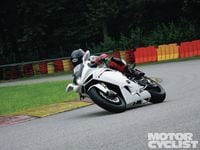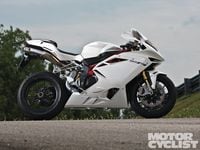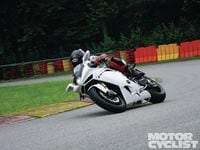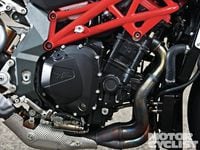After a 15-month stint under Harley-Davidson, MV Agusta is back in Italian hands. With the passing of long-time company President Claudio Castiglioni, his son Giovanni has taken the reins of the historic brand. Aided by new General Manager Massimo Bordi, the former Ducati engineer, it appears that MV Agusta is back in business and geared for success.
That’s an impression that was cemented by the debut of the F4RR Corsacorta, powered by MV's first new four-cylinder engine since 2005. While retaining the same styling as the previous F4, the RR is powered by a completely new short-stroke (corsa corte in Italian) engine that was engineered to restore the F4’s reputation as a lightning-fast sportbike.
The F4RR’s new 998cc powerplant has extremely oversquare bore and stroke figures (79.0 x 50.9mm), enabling the engine to spin faster and produce more power. The cylinder head comes from the same casting as before, but the combustion chamber design and intake and exhaust ports have been reshaped. Compression is up from 13.2:1 to 13.4:1, and valve diameter has grown from 30.0 to 31.8mm on the intake side and from 25.0 to 26.0mm on the exhaust side. Both the intake and exhaust valves are made of titanium, and the intake charge is fed through massive 49mm Mikuni throttle bodies with dual-stage injectors.
These changes were enacted to produce more power, and based on the spec sheet the project was a success. The Corsacorta motor is said to deliver 200 horsepower at 13,280 rpm with 84 lb.-ft. of torque at 9200 rpm. That’s a 16-bhp jump up on the previous version’s claimed 184 bhp, and rear-wheel output should be on par with or slightly above that of BMW’s 170-bhp S1000RR.
The frame is the same as before, but a new swingarm pivot and steering head design permit geometry changes via offset inserts. Another notable update is the change from Marzocchi to Öhlins suspension components. Forged-aluminum wheels weigh 2 lbs. less than the previous cast hoops and carry the same fantastic Brembo brakes and Pirelli Diablo Supercorsa tires. Wheelbase remains unaltered at 56.3 inches, and claimed curb weight is still a rather porky 450 lbs.
I had a ride on the F4RR at Pirelli’s Vizzola Ticino test track near Milan’s Malpensa Airport. The course’s long front straight and variation of turns was a good place to get a feel for the new engine’s power, and of what this Superbike contender really has to offer.
It took just moments to find out, because the F4RR’s performance improvements were immediately apparent. Acceleration off the line is impressive, and once the engine spins up above 4000 rpm you’d better hold on! Power builds rapidly all the way up to the 13,700-rpm rev limiter, and has you hurrying to grab another gear. With such fluid power delivery it’s a shame the bike doesn’t come with a quick-shifter, but shifting is precise and crisp, which is a good thing since the bike is fitted with a new close-ratio gearbox.
The first session out was experienced in Road mode, and switching to Sport transformed the F4RR’s behavior. Switching drive modes and traction control is easier on this bike thanks to a handlebar-mounted switch—a big improvement over the small dashboard buttons used on the previous model. Sport mode livens up low-rpm performance and unleashes explosive power above 9000 rpm. The effect when the secondary injectors kick in and the variable-length intake trumpets lift is really noticeable—and thrilling!
Despite the bike’s power and the fact that there’s no anti-wheelie program in the Marelli ECU like on Aprilia’s RSV4 Factory APRC, the F4RR’s front tire isn’t all that eager to reach for the sky. Riding the MV you get the impression that there’s a lot of weight on the front wheel, a characteristic that helps keep daylight from getting under it. This forward bias is reflected in the riding position, yet the F4RR isn’t particularly extreme, and could even be described as spacious. A notable ergonomic improvement over the previous model is the addition of adjustable rearsets, although the footpegs still lack enough knurling and are rather slippery. In the lowest position legroom is acceptable and cornering clearance is ample.
The F4RR’s forward weight distribution makes it feel planted in turns, but it’s hard work lifting it up again for the exit, and it definitely takes some effort to flip from side to side at speed. The MV as I rode it dictated quite a physical riding style, but the multi-adjustable nature of the chassis and the fully adjustable Öhlins suspension means you can alter the handling to suit your tastes. Unfortunately, we didn’t have time to experiment.
Build quality is good, although in matte-white the sharpness of the bike’s lines is lost. Aside from color changes, a restyled dash is the only other aesthetic update. The new readout uses italic numerals and script that looks attractive but is rather hard to read.
The F4RR’s performance has certainly been elevated, but so has its price tag. Last year’s bike came in under $19,000, whereas this machine rings in at $24,998. The Corsacorta feels as powerful as any other superbike, but the much less costly BMW S1000RR has a more comprehensive electronics package, as does Aprilia’s $22,000 RSV4 Factory APRC. Still, some buyers are sure to be swayed by the MV’s mesmerizing looks and character. Even if it’s not the baddest bike out there, it’s still good to see MV back to building exceptional sportbikes.
Tech Spec
Evolution
MV's legendary F4 gets a more powerful short-stroke engine, Öhlins suspension, lighter wheels and adjustable rearsets.
Rivals
Aprilia RSV4 Factory APRC, BMW S1000RR, Ducati 1198SP, Kawasaki ZX-10R, Yamaha YZF-R1.
||| |---|---| | Tech| | Price| $24,998| | Engine type| l-c inline-four| | Valve train| DOHC, 16v| | Displacement| 998cc| | Bore x stroke| 79.0 x 50.9mm | | Compression| 13.4:1| | Fuel system| EFI| | Clutch| Wet, multi-plate slipper | | Transmission| 6-speed| | Claimed horsepower| 200 bhp @ 13,400 rpm| | Claimed torque| 84 lb.-ft. @ 9200 rpm| | Frame| Tubular-steel and cast-aluminum with single-sided aluminum swingarm| | Front suspension| Öhlins 43mm NIX30 fork with adjustable spring preload, compression and rebound damping| | Rear suspension| Öhlins TTX36 shock with adjustable spring preload, compression and rebound damping | | Front brake| Dual Brembo Monobloc four-piston calipers, 320mm discs| | Rear brake| Brembo four-piston caliper, 210mm disc| | Front tire| 120/70ZR-17 Pirelli Diablo Supercorsa SP| | Rear tire| 190/55ZR-17 Pirelli Diablo Supercorsa SP| | Rake/trail| 23.5º/4.0 in.| | Seat height| 32.7 in.| | Wheelbase| 56.3 in.| | Fuel capacity| 4.5 gal.| | Claimed curb weight| 450 lbs.| | Colors| Matte-white, red/white| | Available| Now| | Warranty| 24 mo., unlimited mi.| | Contact| MV Agusta USA 10 Canal St. #224 Bristol, PA 19007 215.781.1770 www.mvagustausa.com| | Verdict **| 3.5 out of 5 stars. | **More power and more accommodating ergonomic and electronic interfaces hardly justify a $5000 price increase.















/cloudfront-us-east-1.images.arcpublishing.com/octane/VZZXJQ6U3FESFPZCBVXKFSUG4A.jpg)
/cloudfront-us-east-1.images.arcpublishing.com/octane/QCZEPHQAMRHZPLHTDJBIJVWL3M.jpg)
/cloudfront-us-east-1.images.arcpublishing.com/octane/HXOUJXQWA5HBHGRO3EMJIGFMVI.jpg)

/cloudfront-us-east-1.images.arcpublishing.com/octane/3TIWWRV4JBBOLDVGRYECVVTA7Y.jpg)
/cloudfront-us-east-1.images.arcpublishing.com/octane/KIX5O23D5NAIBGFXBN3327DKZU.jpg)
/cloudfront-us-east-1.images.arcpublishing.com/octane/7GJYDUIPXRGMTMQKN6ONYOLBOU.jpg)
/cloudfront-us-east-1.images.arcpublishing.com/octane/MUQLOVLL2ZDGFH25ILABNBXKTI.jpg)
/cloudfront-us-east-1.images.arcpublishing.com/octane/TNOU5DNE2BC57MFPMGN2EIDXAM.jpg)
/cloudfront-us-east-1.images.arcpublishing.com/octane/GTCXACQGJ5HAPDTGWUQKDEH44E.jpg)
/cloudfront-us-east-1.images.arcpublishing.com/octane/S35YGSEMEZB4BLTDJTSZPF4GLA.jpg)
/cloudfront-us-east-1.images.arcpublishing.com/octane/5UOT6HPX2JFMRJAX6EH45AR4MQ.jpg)
/cloudfront-us-east-1.images.arcpublishing.com/octane/OKWOJWAKP5EP3OACCRRWPCIX2Q.jpg)
/cloudfront-us-east-1.images.arcpublishing.com/octane/2WF3SCE3NFBQXLDNJM7KMXA45E.jpg)
/cloudfront-us-east-1.images.arcpublishing.com/octane/G4MG6OUCJNBSHIS2MVVOTPX65E.jpg)
/cloudfront-us-east-1.images.arcpublishing.com/octane/IIGGWFOTOJGB7DB6DGBXCCMTDY.jpg)
/cloudfront-us-east-1.images.arcpublishing.com/octane/QSTCM6AVEZA5JJBUXNIQ3DSOF4.jpg)
/cloudfront-us-east-1.images.arcpublishing.com/octane/U4I7G625B5DMLF2DVIJDFZVV6M.jpg)
/cloudfront-us-east-1.images.arcpublishing.com/octane/B6XD6LS6IVCQPIU6HXDJSM3FHY.jpg)
/cloudfront-us-east-1.images.arcpublishing.com/octane/ICL63FEDDRDTTMINYICCEYGMDA.jpg)
/cloudfront-us-east-1.images.arcpublishing.com/octane/FCGZHQXRBZFLBAPC5SDIQLVF4I.jpg)
/cloudfront-us-east-1.images.arcpublishing.com/octane/WNOB6LDOIFFHJKPSVIWDYUGOPM.jpg)

/cloudfront-us-east-1.images.arcpublishing.com/octane/X33NU3E525ECRHXLNUJN2FTRKI.jpg)